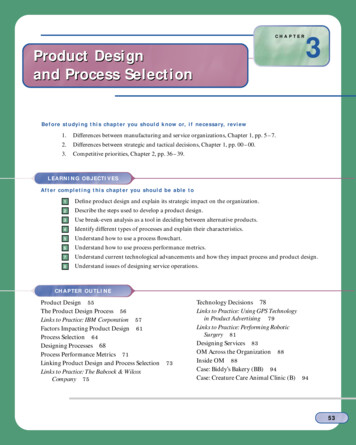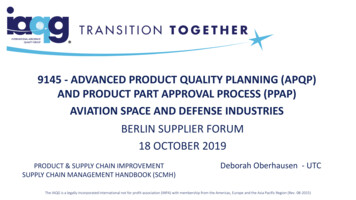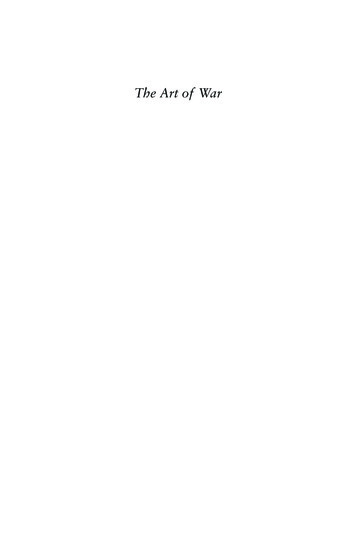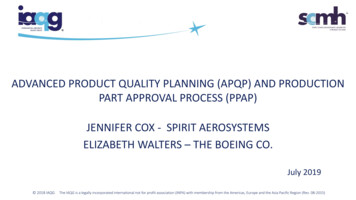
Transcription
CHAPTERProduct Designand Process Selection3Before studying this chapter you should know or, if necessary, review1.2.3.Differences between manufacturing and service organizations, Chapter 1, pp. 5 – 7.Differences between strategic and tactical decisions, Chapter 1, pp. 00 – 00.Competitive priorities, Chapter 2, pp. 36 – 39.LEARNING OBJECTIVESAfter completing this chapter you should be able to12345678Define product design and explain its strategic impact on the organization.Describe the steps used to develop a product design.Use break-even analysis as a tool in deciding between alternative products.Identify different types of processes and explain their characteristics.Understand how to use a process flowchart.Understand how to use process performance metrics.Understand current technological advancements and how they impact process and product design.Understand issues of designing service operations.CHAPTER OUTLINEProduct Design 55The Product Design Process 56Links to Practice: IBM Corporation 57Factors Impacting Product Design 61Process Selection 64Designing Processes 68Process Performance Metrics 71Linking Product Design and Process SelectionLinks to Practice: The Babcock & WilcoxCompany 7573Technology Decisions 78Links to Practice: Using GPS Technologyin Product Advertising 79Links to Practice: Performing RoboticSurgery 81Designing Services 83OM Across the Organization 88Inside OM 88Case: Biddy’s Bakery (BB) 94Case: Creature Care Animal Clinic (B) 9400053
54 CHAPTER 3PRODUCT DESIGN AND PROCESS SELECTIONave you ever been with a group offriends and decided to order pizzas?One person wants pizza from Pizza Hut because he likes the taste of stuffed-crust pizzamade with cheese in the crust. Someoneelse wants Donatos pizza because she likesthe unique crispy-thin crust. A third wantspizza from Spagio’s because of the woodgrilled oven taste. Even a simple productlike a pizza can have different featuresunique to its producer. Different customershave different tastes, preferences, and product needs. The variety of product designson the market appeal to the preferences of aparticular customer group. Also, the different product designs have different processing requirements. This is what product design and process selection are all about.We can all relate to the product design ofa pizza just from everyday life. Now considerthe complexities involved in designing moresophisticated products. For example, Palm,Inc. (www.palm.com) is a leading provider of handheld computers whose slogan is “different people, different needs, different handhelds.” The company designs different products with differing capabilities, such as personal information management, wireless Internet access, and games, intended for different types of customers. The company also has todecide on the best process to produce the different types of handhelds.The challenge of product design can also be illustrated by an example of the AlzaCorporation. Alza is a leader in designing new ways that pharmaceutical drugs can beadministered to different types of patients. One of their product designs is an underthe skin implant for pharmaceutical drugs that previously could only be administeredby injection. The product design had to include time release of the drug, as well as thebest material and shape of the implant. In addition to the product design, a processhad to be designed to produce the unique product.These examples illustrate that a product design that meets customer needs, although challenging, can have a large impact on a company’s success. In fact, productdesign is so important that leading edge companies routinely invest in productdesigns well into the future. For example, Daimler Chrysler has been conducting research to design intelligent technologies for their vehicles that would have pedestrianand street sign recognition systems. This type of innovative product design can give acompany a significant competitive advantage.H
PRODUCT DESIGN 55In this chapter we will learn about product design, which is the process of deciding onthe unique characteristics and features of the company’s product. We will also learnabout process selection, which is the development of the process necessary to producethe designed product. Product design and process selection decisions are typicallymade together. A company can have a highly innovative design for its product, but ifit has not determined how to make the product in a cost effective way, the productwill stay a design forever.Product design and process selection affect product quality, product cost, and customer satisfaction. If the product is not well designed or if the manufacturing processis not true to the product design, the quality of the product may suffer. Further, theproduct has to be manufactured using materials, equipment, and labor skills that areefficient and affordable; otherwise, its cost will be too high for the market. We call thisthe product’s manufacturability — the ease with which the product can be made. Finally, if a product is to achieve customer satisfaction, it must have the combined characteristics of good design, competitive pricing, and the ability to fill a market need.This is true whether the product is pizzas or cars. ManufacturabilityThe ease with which aproduct can be made.PRODUCT DESIGNMost of us might think that the design of a product is not that interesting. After all, itprobably involves materials, measurements, dimensions, and blueprints. When wethink of design we usually think of car design or computer design and envision engineers working on diagrams. However product design is much more than that.Product design brings together marketing analysts, art directors, sales forecasters,engineers, finance experts, and other members of a company to think and planstrategically. It is exciting and creative, and it can spell success or disaster for acompany.Product design is the process of defining all the features and characteristics of justabout anything you can think of, from Starbuck’s cafe latte or Jimmy Dean’s sausageto GM’s Saturn or HP’s DeskJet printer. Product design also includes the design ofservices, such as those provided by Salazar’s Beauty Salon, La Petite Academy DayCare Center, or FedEx. Consumers respond to a product’s appearance, color, texture,performance. All of its features, summed up, are the product’s design. Someone cameup with the idea of what this product will look like, taste like, or feel like so that it willappeal to you. This is the purpose of product design. Product design defines a product’s characteristics, such as its appearance, the materials it is made of, its dimensionsand tolerances, and its performance standards.Marketing, Finance Product designThe process of defining all ofthe product’s characteristics.Design of Services Versus GoodsThe design elements discussed are typical of industries such as manufacturing and retail in which the product is tangible. For service industries, where the product isintangible, the design elements are equally important, but they have an addeddimension.Service design is unique in that we are designing both the service and the entireservice concept. As with a tangible product, the service concept is based on meetingcustomer needs. The service design, however, adds the esthetic and psychological benefits of the product. These are the service elements of the operation, such as prompt-The Sony Clié is one of thelatest product designs inhandheld computer devicesthat combine portability,power, and features.
56 CHAPTER 3PRODUCT DESIGN AND PROCESS SELECTION Service designThe process of establishing allthe characteristics of theservice, including physical,sensual, and psychologicalbenefits.ness and friendliness. They also include the ambiance, image, and “feel-good” elements of the service. Consider the differences in service design of a company likeCanyon Ranch, which provides a pampering retreat for health-conscious but overworked professionals, versus Gold’s Gym, which caters to young athletes. As with atangible product, the preference for a service is based on its product design. Servicedesign defines the characteristics of a service, such as its physical elements, and theesthetic and psychological benefits it provides.THE PRODUCT DESIGN PROCESSCertain steps are common in the development of most product designs. They are ideageneration, product screening, preliminary design and testing, and final design. Thesesteps are shown in Figure 3-1. Notice that the arrows show a circular process. Productdesigns are never finished, but are always updated with new ideas. Let’s look at thesesteps in more detail.Idea DevelopmentAll product designs begin with an idea. The idea might come from a product managerwho spends time with customers and has a sense of what customers want, from anengineer with a flare for inventions, or from anyone else in the company. To remaincompetitive, companies must be innovative and bring out new products regularly. Insome industries, the cycle of new product development is predictable. We see this inthe auto industry, where new car models come out every year, or the retail industry,where new fashion is designed for every season.In other industries, new product releases are less predictable but just as important.The Body Shop, retailer of plant-based skin care products, periodically comes up withnew ideas for its product lines. The timing often has to do with the market for a product, and whether sales are declining or continuing to grow.FIGURE 3-1Steps in the product designprocessIdeas from Customers, Competitors, and Suppliers The first source of ideas arecustomers, the driving force in the design of goods and services. Marketing is a ign & TestingFinalDesignProduct ideadeveloped; Sourcescan be customers,competitors, orsuppliersProduct ideaevaluated; Need toconsider operations,marketing, andfinancial requirementsProduct prototypesbuilt, tested, andrefinedFinal productspecificationscompleted
THE PRODUCT DESIGN PROCESS 57link between customers and product design. Market researchers collect customer information by studying customer buying patterns and using tools such as customersurveys and focus groups. Management may love an idea, but if market analysis showsthat customers do not like it, the idea is not viable. Analyzing customer preferences isan ongoing process. Customer preferences next year may be quite different from whatthey are today. For this reason, the related process of forecasting future consumerpreferences is important, though difficult.Competitors are another source of ideas. A company learns by observing its competitors’ products and their success rate. This includes looking at product design,pricing strategy, and other aspects of the operation. Studying the practices of companies considered “best in class” and comparing the performance of our companyagainst theirs is called benchmarking. We can benchmark against a company in acompletely different line of business and still learn from some aspect of that company’s operation. For example, Lands’ End is well known for its successful catalogbusiness, and companies considering catalog sales often benchmark against Lands’End. Similarly, American Express is a company known for its success at resolvingcomplaints, and it, too, is used for benchmarking.The importance of benchmarking can be seenby the efforts taken by IBM to improve its distribution system. In 1997 IBM found its distribution costs increasing, while customerswere expecting decreasing cycle times fromfactory to delivery. It appeared that IBM’ssupply chain practices were not keeping upwith those of its competitors. To evaluate andsolve this problem IBM hired Mercer Management Consultants, who performed a largebenchmarking study. IBM’s practices werecompared to those of market leaders in thepersonal computer (PC) industry, as well asto the best logistics practices outside the technology area. The objective was to evaluateIBM’s current performance, that of companies considered best-in-class, and identify thegaps. Through the study, IBM discovered which specific costs exceeded industrybenchmarks and which parts of the cycle time were excessively long. It also uncoveredways to simplify and reorganize its processes to gain efficiency. Based on findingsfrom the benchmarking effort, IBM made changes in its operations. The results werereduced costs, improved delivery, and improved relationships with suppliers. IBMfound benchmarking so beneficial that it plans to perform similar types of studies onan ongoing basis in the future.Reverse Engineering Another way of using competitors’ ideas is to buy a competitor’s new product and study its design features. Using a process called reverse engineering, a company’s engineers carefully disassemble the product and analyze itsparts and features. This approach was used by the Ford Motor Company to design itsTaurus model. Ford engineers disassembled and studied many other car models, suchas BMW and Toyota, and adapted and combined their best features. Product designMarketing BenchmarkingThe process of studying thepractices of companiesconsidered “best in class” andcomparing your company’sperformance against theirs.LINKS TO PRACTICEIBM Corporationwww.ibm.com Reverse engineeringThe process of disassemblinga product to analyze itsdesign features.
58 CHAPTER 3PRODUCT DESIGN AND PROCESS SELECTION Early supplierinvolvement (ESI)Involving suppliers in theearly stages of productdesign.ideas are also generated by a company’s R & D (research and development) department, whose role is to develop product and process innovation.Suppliers are another source of product design ideas. To remain competitivemore companies are developing partnering relationships with their suppliers, tojointly satisfy the end customer. For example, Daimler Chrysler chooses itssuppliers well before parts are designed. Suppliers participate in a program calledearly supplier involvement (ESI) where suppliers are involved in the early stages ofproduct design.Product ScreeningAfter a product idea has been developed it is evaluated to determine its likelihood ofsuccess. This is called product screening. The company’s product screening team evaluates the product design idea according to the needs of the major business functions.In their evaluation, executives from each function area may explore issues such as thefollowing: Marketing, Finance Operations What are the production needs of the proposed new product andhow do they match our existing resources? Will we need new facilities andequipment? Do we have the labor skills to make the product? Can the materialfor production be readily obtained?Marketing What is the potential size of the market for the proposed new product? How much effort will be needed to develop a market for the product andwhat is the long-term product potential?Finance The production of a new product is a financial investment like anyother. What is the proposed new product’s financial potential, cost, and returnon investment?Unfortunately, there is no magic formula for deciding whether or not to pursue aparticular product idea. Managerial skill and experience, however, are key. Companiesgenerate new product ideas all the time, whether for a new brand of cereal or a newdesign for a car door. Approximately 80 percent of ideas do not make it past thescreening stage. Management analyzes operations, marketing, and financial factors,and then makes the final decision. Fortunately, we have decision-making tools to helpus evaluate new product ideas. A popular one is break-even analysis, which we look atnext. Break-even analysisA technique used to computethe amount of goods acompany would need to sellto cover its costs. Fixed costsCosts a company incursregardless of how much itproduces. Variable costsCosts that vary directly withthe amount of units produced.Break-Even Analysis: A Tool for Product Screening Break-even analysis is atechnique that can be useful when evaluating a new product. This technique computes the quantity of goods a company needs to sell just to cover its costs, or breakeven, called the “break-even” point. When evaluating an idea for a new product it ishelpful to compute its break-even quantity. An assessment can then be made as tohow difficult or easy it will be to cover costs and make a profit. A product with abreak-even quantity that is hard to attain might not be a good product choice to pursue. Next we look at how to compute the break-even quantity.The total cost of producing a product or service is the sum of its fixed and variablecosts. A company incurs fixed costs regardless of how much it produces. Fixed costsinclude overhead, taxes, and insurance. For example, a company must pay for overhead even if it produces nothing. Variable costs, on the other hand, are costs thatvary directly with the amount of units produced, and include items such as direct
THE PRODUCT DESIGN PROCESS 59materials and labor. Together, fixed and variable costs add up to total cost:Total cost F (VC) Qwhere F fixed costVC variable cost per unitQ number of units soldFigure 3-2 shows a graphical representation of these costs as well as the break-evenquantity. Fixed cost is represented by a horizontal line as this cost is the same regardless of how much is produced. Adding variable cost to fixed cost creates total cost, represented by the diagonal line above fixed cost. When Q 0, total cost is only equal tofixed cost. As Q increases, total cost increases through the variable cost component.The blue diagonal in the figure is revenue, the amount of money brought in fromsales:Revenue (SP) Qwhere SP selling price per unitWhen Q 0, revenue is zero. As sales increase, so does revenue. Remember, however,that to cover all costs we have to sell the break-even amount. This is the quantity QBE,where revenue equals total cost. If we sell below the break-even point we incur a loss,since costs exceed revenue. To make a profit, we have to sell above the break-evenpoint. Since revenue equals total cost at the break-even point, we can use the previousequations to compute the value of the break-even quantity:Total cost total revenueF (VC) Q (SP) QSolving for Q, we get the following equation:Q BE FSP VCNote that we could also find the break-even point by drawing the graph and findingwhere the total cost and revenue lines cross.FIGURE 3-2Dollars ( )Total RevenueProfitTotal CostBreak-evenQuantityLossFixed CostsQ BEQuantity (in units)Graphical approach tobreak-even analysis
60 CHAPTER 3PRODUCT DESIGN AND PROCESS SELECTIONEXAMPLE 3.1Computing theBreak-EvenQuantityFred Boulder, owner of Sports Feet Manufacturing, is considering whether to produce a new line offootwear. Fred has considered the processing needs for the new product as well as the market potential. He has also estimated that the variable cost for each product manufactured and sold is 9 andthe fixed cost per year is 52,000.(a) If Fred offers the footwear at a selling price of 25, how many pairs must he sell to break even?(b) If Fred sells 4000 pairs at the 25 price, what will be the contribution to profit? Solution(a) To compute the break-even quantity:Q FSP VC 52,000 3250 pairs 25 9The break-even quantity is 3250 pairs. This is how much Fred would have to sell to cover costs.(b) To compute the contribution to profit with sales of 4000 pairs we can go back to the relationship between cost and revenue:Profit total revenue total cost (SP) Q [F (VC) Q]Profit 25 (4000) [ 52,000 9 (4000)] 12,000The contribution to profit is 12,000 if Fred can sell 4000 pairs from his new line of footwear.Break-even analysis is useful for more than just deciding between different products. It can be used to make other decisions, such as evaluating different processes ordeciding whether the company should make or buy a product.Preliminary Design and TestingOnce a product idea has passed the screening stage, it is time to begin preliminarydesign and testing. At this stage, design engineers translate general performance specifications into technical specifications. Prototypes are built and tested. Changes aremade based on test results, and the process of revising, rebuilding a prototype, andtesting continues. For service companies this may entail testing the offering on a smallscale and working with customers to refine the service offering. Fast-food restaurantsare known for this type of testing, where a new menu item may be tested in only oneparticular geographic area. Product refinement can be time consuming, and theremay be a desire on the part of the company to hurry through this phase to rush theproduct to market. However, rushing creates the risk that all the “bugs” have not beenworked out, which can prove very costly.
FACTORS IMPACTING PRODUCT DESIGN 61Final DesignFollowing extensive design testing the product moves to the final design stage. This iswhere final product specifications are drawn up. The final specifications are thentranslated into specific processing instructions to manufacture the product, which include selecting equipment, outlining jobs that need to be performed, identifying specific materials needed and suppliers that will be used, and all the other aspects of organizing the process of product production.FACTORS IMPACTING PRODUCT DESIGNHere are some additional factors that need to be considered during the productdesign stage.Design for ManufactureWhen we think of product design we generally first think of how to please the customer. However, we also need to consider how easy or difficult it is to manufacturethe product. Otherwise, we might have a great idea that is difficult or too costly tomanufacture. Design for manufacture (DFM) is a series of guidelines that we shouldfollow to produce a product easily and profitably. DFM guidelines focus on two issues:1. Design simplification means reducing the number of parts and features of theproduct whenever possible. A simpler product is easier to make, costs less, andgives us higher quality.2. Design standardization refers to the use of common and interchangeable parts.By using interchangeable parts we can make a greater variety of products withless inventory and significantly lower cost and provide greater flexibility. Table3-1 shows guidelines for DFM. Design for manufacture(DFM)A series of guidelines tofollow in order to produce aproduct easily and profitably.An example of the benefits of applying these rules is seen in Figure 3-3. We can seethe progression in the design of a toolbox using the DFM approach. All of the pictures show a toolbox. However, the first design shown requires 20 parts. Through simplification and use of modular design the number of parts required has been reducedto 2. It would certainly be much easier to make the product with 2 parts versus 20parts. This means fewer chances for error, better quality, and lower costs due toshorter assembly time.DFM guidelines include the following:1.2.3.4.5.Minimize parts.Design parts for different products.Use modular design.Avoid tools.Simplify operations.TABLE 3-1Guidelines for DFM
62 CHAPTER 3PRODUCT DESIGN AND PROCESS SELECTIONFIGURE 3-3Progressive design of a toolboxusing DFMProduct Life Cycle Product life cycleA series of stages thatproducts pass through intheir lifetime, characterizedby changing productdemands over time.Another factor in product design is the stage of the life cycle of the product. Mostproducts go through a series of stages of changing product demand called the product life cycle. There are typically four stages of the product life cycle: introduction,growth, maturity, and decline. These are shown in Figure 3-4.Products in the introductory stage are not well defined and neither is their market.Often all the “bugs” have not been worked out and customers are uncertain about theproduct. In the growth stage, the product takes hold and both product and marketcontinue to be refined. The third stage is that of maturity, where demand levels offand there are usually no design changes: The product is predictable at this stage andso is its market. Many products, such as toothpaste, can stay in this stage for manyyears. Finally, there is a decline in demand, because of new technology, better productdesign, or market saturation.The first two stages of the life cycle can collectively be called the early stages of theproduct life cycle because the product is still being improved and refined, and theFIGURE 3-4Early Stages of ProductLife CycleStages of the product life cycleLater Stages of ProductLife me
FACTORS IMPACTING PRODUCT DESIGN 63market is still in the process of being developed. The last two stages of the life cyclecan be referred to as the later stages because here the product and market are bothwell defined.Understanding the stages of the product life cycle is important for product designpurposes, such as knowing at which stage to focus on design changes. Also, when considering a new product, the expected length of the life cycle is critical in order to estimate future profitability relative to the initial investment. The product life cycle canbe quite short for certain products, as seen in the computer industry. For other products it can be extremely long, as in the aircraft industry. A few products, such as paper,pencils, nails, milk, sugar, and flour, do not go through a life cycle. However, almostall products do, and some may spend a long time in one stage.Concurrent EngineeringConcurrent engineering is an approach that brings many people together in the earlyphase of product design in order to simultaneously design the product and theprocess. This type of approach has been found to achieve a smooth transition fromthe design stage to actual production in a shorter amount of development time withimproved quality results.The old approach to product and process design was to first have the designers ofthe idea come up with the exact product characteristics. Once their design was complete they would pass it on to operations who would then design the productionprocess needed to produce the product. This was called the “over-the-wall” approach,because the designers would throw their design “over-the-wall” to operations whothen had to decide how to produce the product.There are many problems with the old approach. First, it is very inefficient andcostly. For example, there may be certain aspects of the product that are not criticalfor product success but are costly or difficult to manufacture, such as a dye color thatis difficult to achieve. Since manufacturing does not understand which features arenot critical, it may develop an unnecessarily costly production process with costspassed down to the customers. Because the designers do not know the cost of theadded feature, they may not have the opportunity to change their design or may do somuch later in the process, incurring additional costs. Concurrent engineering allowseveryone to work together so these problems do not occur. Figure 3-5 shows the difference between the “over-the-wall” approach and concurrent engineering.A second problem is that the “over-the-wall” approach takes a longer amount oftime than when product and process design are performed concurrently. As you cansee in Figure 3-5, when product and process design are made together much of thework is done in parallel rather than in sequence. In today’s markets, new product introductions are expected to occur faster than ever. Companies do not have the luxuryof enough time to follow a sequential approach and then work the “bugs” out. Theymay eventually get a great product, but by then the market may not be there!The third problem is that the old approach does not create a team atmosphere,which is important in today’s work environment. Rather, it creates an atmospherewhere each function views its role separately in a type of “us versus them” mentality.With the old approach, when the designers were finished with the designs, they considered their job done. If there were problems, each group blamed the other. Withconcurrent engineering the team is responsible for designing and getting the productto market. Team members continue working together to resolve problems with theproduct and improve the process. Concurrent engineeringAn approach that bringstogether multifunction teamsin the early phase of productdesign in order tosimultaneously design theproduct and the process.Marketing, Engineering
64 CHAPTER 3PRODUCT DESIGN AND PROCESS SELECTIONFIGURE 3-5The first illustrationshows sequentialdesign with wallsbetween functionalareas. The secondillustration showsconcurrent design withwalls broken down.(a) Sequential design: Walls between functional specsManufacturingengineerProductionpersonnel(b) Concurrent design: Walls broken downDesignteamRemanufacturing RemanufacturingThe concept of usingcomponents of old productsin the production of newones.Remanufacturing is a concept that has been gaining increasing importance, as our society becomes more environmentally conscious and focuses on efforts such as recycling and eliminating waste. Remanufacturing uses components of old products inthe production of new ones. In addition to the environmental benefits, there are significant cost benefits because remanufactured products can be half the price of theirnew counterparts. Remanufacturing has been quite popular in the production ofcomputers, televisions, and automobiles.PROCESS SELECTIONSo far we have discussed issues involved in product design. Though product design isimportant for a company, it cannot be considered separately from the selection of theprocess. In this section we will look at issues involved i
The design elements discussed are typical of industries such as manufacturing and re-tail in which the product is tangible. For service industries, where the product is intangible, the design elements are equally important, but they have an added dimension. Service design is unique in that we are designing both the service and the entire











